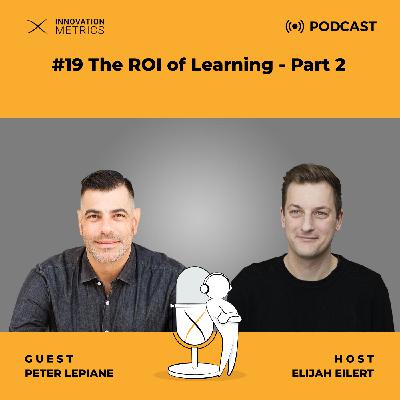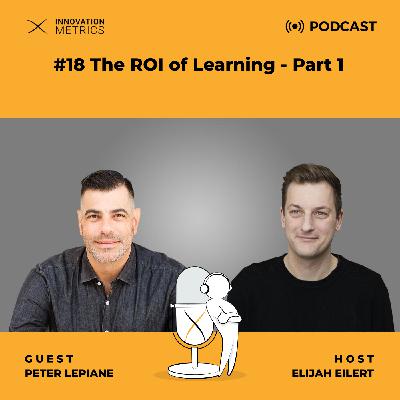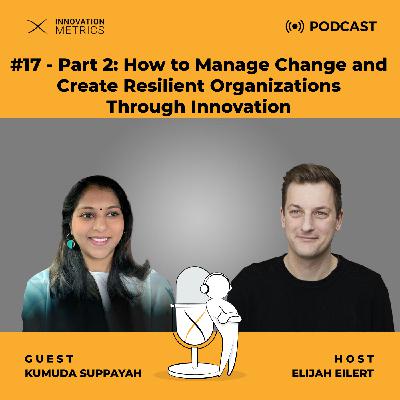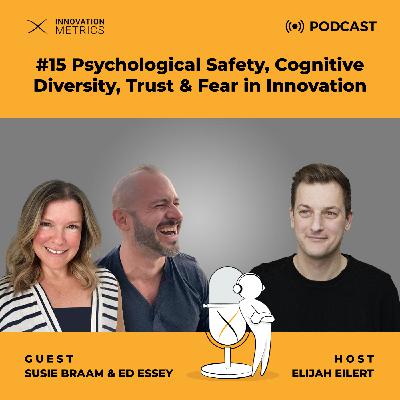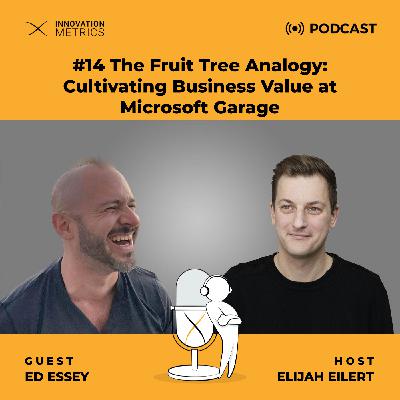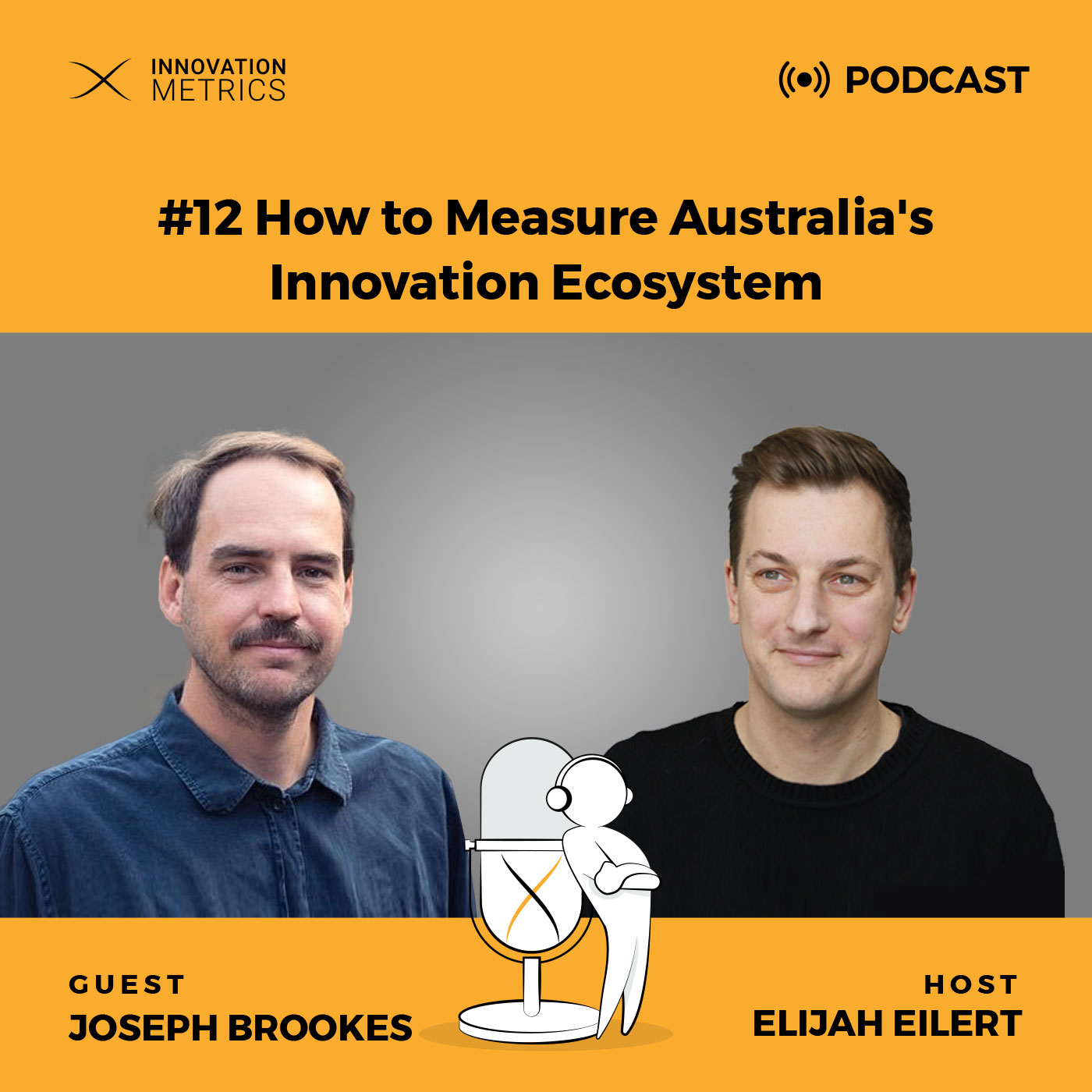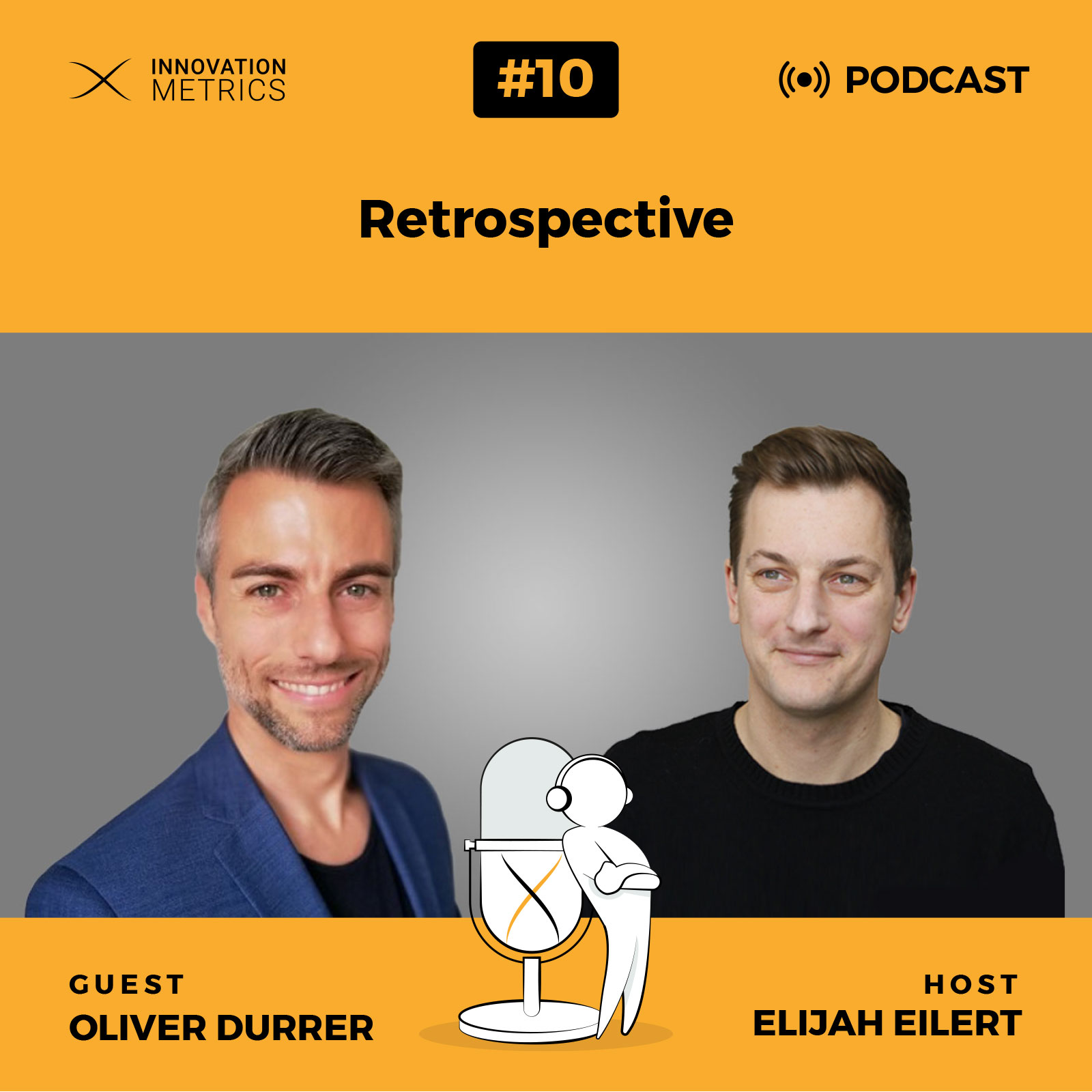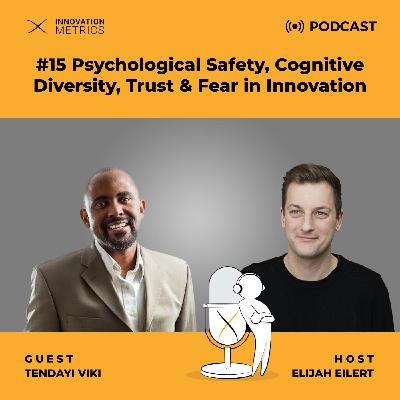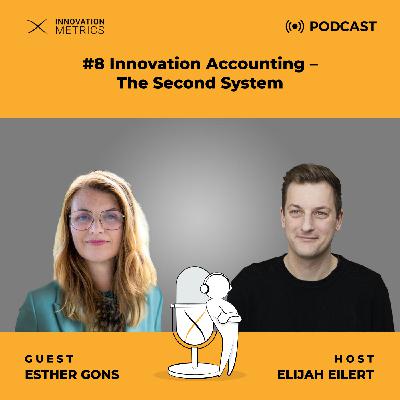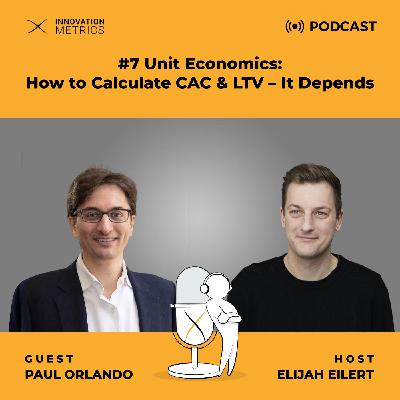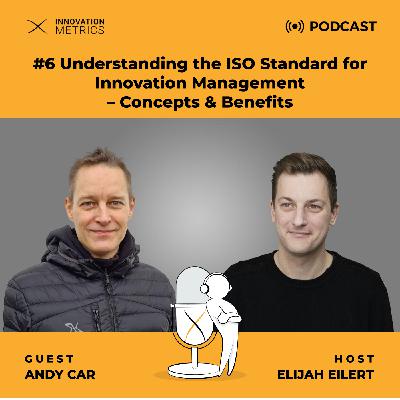Discover Innovation Metrics Podcast
Innovation Metrics Podcast

Innovation Metrics Podcast
Author: Elijah Eilert
Subscribed: 3Played: 8Subscribe
Share
© Copyright 2025 Elijah Eilert
Description
Welcome to the Innovation Metrics podcast where we geek about Innovation Management.
We bring you insights on how to measure innovation, innovation accounting and managing the uncertain process of developing new, sustainable and profitable business models.
We bring you insights on how to measure innovation, innovation accounting and managing the uncertain process of developing new, sustainable and profitable business models.
22 Episodes
Reverse
About the EpisodeCorporate innovation pioneer and former Citi Chief Innovation Officer Amy Radin joins host Elijah Eilert to explain how large, regulated organisations can move quickly without losing control. Amy shares how to turn likely vetoes into informed sponsorship. The conversation covers why disciplined, low-cost experiments generate decision-ready evidence, how strategic advocacy helps innovators win allies, and why partnering with finance and risk teams can convert uncertainty into competitive advantage. Amy also predicts that modular, interdisciplinary certificates will soon displace traditional MBAs as the preferred path for innovation leaders. From growing up in a small family business to navigating corporate boardrooms, Amy shares both the lessons she has learned and unlearn, insights every innovation leader can put to work today.The Change Maker’s Playbook Topics & Insights[00:20] Introducing Amy Radin: One of the first corporate Chief Innovation Officers in the world, dedicated to solving real customer problems.[01:03] Defining innovation: New and viable solutions that meet unmet rational and emotional needs within legal, ethical and commercial limits.[02:35] The innovation spectrum: “New” is relative to your company or market; incremental changes can be transformative internally.[03:53] Metric pitfalls: Mature-business ROI hurdles choke exploration, focus first on learning milestones and evidence.[05:24] Listen before you survey: Qualitative observation often outperforms data sets when desirability is uncertain.[06:43] Empathy for CFOs: Understand that finance leaders are paid to protect cash flow and manage certainty. Apply the same discovery techniques you use with customers to CFOs: frame proposals as stage-gated micro-bets with clear spending caps, predefined kill criteria and measurable learning goals. Translating risk into the language of liquidity, runway and downside protection builds their confidence to fund experimentation.[09:31] Budgeting experiments: Treat rapid tests as investments that generate decision-grade data.[13:50] The corporate tax: In a big organisation, persuading decision-makers and influencers is not a side task, it is a huge part of the job. Innovators must decide whether they are willing to invest that time and energy to win sponsorship and move ideas forward.[16:48] Strategic advocacy: Treat innovation like a social movement. Systematically map champions, fence-sitters and blockers; tailor value propositions and small “next step” asks for each group and build a visible coalition that tips policy, budget and culture from maybe to yes.[22:25] Risk Review Committee: While piloting peer-to-peer mobile payments at Citi, Amy assembled a cross-functional forum brand, legal, compliance, cyber-security and enterprise-risk, before any contracts were drafted. By surfacing objectives early, walking through “what-if” scenarios and co-designing safeguards (smallest viable test, rapid-exit plan, advance regulator briefings), the team cut approval time, tightened controls and converted risk leaders from potential blockers into active sponsors.[26:14] Innovation as risk management: In fast-moving markets, clinging to the status quo can expose the business to greater...
EP 21 - Too much Hype, too little Impact: How to Avoid the AI Failures of OthersAbout the EpisodeAI adoption is skyrocketing, but most AI projects don’t deliver on their promises. In this episode, Dr. Evan Shellshear, Managing Director and Group CEO of Ubidy, breaks down why 80% of AI projects fail and what organisations can do to improve their chances of success.Drawing insights from his book Why Data Science Projects Fail, Evan explores the biggest blockers to AI success, the importance of strategic alignment, and how companies can avoid wasting millions on AI initiatives that don’t deliver business impact.Whether you are an AI practitioner, business leader, or innovation manager, this episode will help you separate AI hype from reality and make smarter technology investment decisions.Evan's BooksWhy Data Science Projects Fail: The Harsh Realities of Implementing AI and Analytics, without the Hype:https://www.amazon.com.au/Why-Data-Science-Projects-Fail/dp/103266133X?ref_=ast_author_dp Innovation Tools: The most successful techniques to innovate cheaply and effectively:https://www.amazon.com.au/Innovation-Tools-Successful-Techniques-Effectively/dp/0646956469?ref_=ast_author_dp Topics and Insights[02:53] – Defining InnovationEvan shares his perspective on what defines innovation, emphasising that it is not just about new ideas but the impact they create. He draws a clear distinction between invention and innovation, explaining why an idea without impact remains an invention rather than a true innovation.[04:27] – Measuring Innovation EffectivelyInnovation measurement starts with two key questions: Is it new? and What is its impact? Evan highlights the difficulty of measuring “newness” and discusses why impact should be measured based on purpose-driven innovation. He argues that metrics should align with a company’s innovation goals, whether it is patent creation, revenue growth, or industry transformation.[06:11] – The Biggest Blockers to Innovation in Large OrganizationsEvan contrasts the flexibility of small, nimble companies with the structural challenges of large enterprises. He explains how legacy systems, bureaucratic processes, and internal competition create significant barriers to innovation, making it difficult for new ideas to gain traction and survive within large corporations.[07:31] – Why AI Projects Fail: The 80% Failure RateEvan breaks down the staggering failure rate of AI projects, estimating that up to 80% fail, with the number exceeding 90% for analytically immature organizations. He highlights the three biggest reasons AI initiatives go wrong:Lack of strategic alignment – Organizations chase AI trends without clear business objectives.Poor data quality and availability – Without the right data, even the best AI models fail.Lack of experienced resources – Many AI teams lack deep expertise, leading to unrealistic expectations and weak execution.[12:50] – The Outback AI Story: When AI Doesn’t Make Business SenseEvan shares a fictitious story from Australia’s Outback, where a farmer was pitched an AI-driven solution for managing crops. While the...
About the EpisodeIn this episode, Elijah Eilert sits down with Étienne Garbugli. Étienne, the CEO of Sliced, veteran founder, and author of several books, shares his insights.The conversation centers around Étienne’s most recent book, Find Your Market. The book explores how to effectively find Product/Market Fit when innovations are already built or at least partially developed without having factored in the market need properly. Most innovators understand the need for research and experimentation before committing significant resources to but in reality, many organisations, Research and Development departments, and especially universities all too often do not adhere to it. Topics and Insights[01:00] Question 1: What is Innovation?Étienne kicks off by reframing how we should think about innovation—not just products, but improvements in services, processes, and distribution. He makes a strong case for continuous iteration as the key to staying relevant in today’s hyper-competitive landscape.[02:30] – Question 2: How Should Innovation Be Measured?Étienne discusses different approaches to measuring innovation, from immediate goals (Horizon 1) to long-term, high-uncertainty efforts. He shares his perspective on why understanding progress in increments is key, especially when navigating high-risk innovation projects.[05:00] – Question 3: What is the Biggest Barrier to Innovation?Elijah and Étienne explore a major, yet often overlooked, barrier to innovation—career progression. In organisations, those who get promoted are often seen as people who make the “right” decisions. This clashes with the exploratory and uncertain nature of genuine innovation, which frequently involves taking risks and failing.[12:30] – Finding Your MarketA significant portion of the conversation focuses on Étienne’s book, Find Your Market: Discover and Win Your Product’s Best Market Opportunity. He walks listeners through his bottom-up approach to identifying markets—starting from precise, actionable customer segments and expanding outward—contrasted against traditional top-down TAM analysis. Elijah and Étienne jokingly refer to it as “Lean Startup, but backwards,” emphasising how companies with an existing product can work backward to find Product/Market-Fit but in a lean way.[18:00] – Innovation Metrics and Strategy AlignmentThey discuss how to align innovation metrics with broader business strategy. Measuring learning outcomes and value creation through insights—rather than just focusing on short-term financial gains. Étienne also shares how even seasoned entrepreneurs often realise their understanding of markets evolves significantly over time.[36:30] – Segmenting Effectively with SliceÉtienne explains how his company, Sliced helps companies break down broader target audiences into smaller, more actionable segments. This process enables companies to better understand where their true market opportunities...
About the EpisodeElijah Eilert is talking to Peter LePiane about innovation within large organizations. Part 2 of the podcast explores various aspects of innovation related decision-making. Peter opens up about his background in science and computer science, his Startup journey and how he nearly founded Airbnb and Shopify. He introduces Estimatic, his latest venture, software designed to model uncertain projects and ideas.The episode addresses the concept of innovation accounting, common misconceptions in business case analysis, and the value of information by connecting learning to financial outcomes. The episode challenges traditional practices in organizations and focuses on the importance of understanding human behaviour to achieve success for new products and organisational change management.Throughout this episode, the duo explores a myriad of topics central to innovation-related decision-making and highlights the value of information, connecting it to financial outcomes. Unravelling the concept of innovation accounting, Peter debunks the common misconceptions prevalent in business case analysis. The episode challenges traditional practices and underscores the pivotal role of comprehending human behaviour in achieving success, whether for new products or the intricacies of change management within organizations.Topics and Insights [01:43] Understanding Human Behavior in Change ManagementProducts succeed or fail based on human behavior, as do organizational changes. Understanding human behavior is therefore crucial.Peter recommends checking out Lean Change Management and gives a shoutout to Jason Little![05:23] Peter’s BackgroundPeter’s background as a software engineer.How he transitioned from science to computer science at the University of Waterloo.His journey into the startup world.How Peter launched Airbnb and Shopify (kinda).Peter’s experience working on web development and e-commerce projects.[16:15] EstimaticPeter explains his startup, Estimatic, a Monte Carlo tool for modelling uncertainties.The importance of accurately depicting uncertainty in business models.Critique of the misleading hockey stick growth projections in startup presentations.The need to provide a range with a probability of future outcomes instead of point predictions.[25:51] Challenges in Corporate Innovation Decision-Making Addressing the challenges of making decisions in large corporations.Mentioning the lack of recognition for risk management in decision-making.Highlighting the absence of structures rewarding risk management.[26:53] The Concept of Innovation AccountingElijah and Peter delve into the concept of innovation accounting and its evolution.Explain how innovation accounting combines the uncertain nature of innovation with concrete numerical measurements.Emphasize the importance of connecting learning to financial outcomes.Discussing the use of Monte Carlo simulations in innovation accounting.Quantifying Learning and Progress...
About the EpisodeElijah Eilert is talking to Peter LePiane about innovation within large organizations. Part one of the podcast, explores the core principles of innovation, the challenges associated with measuring its impact, and the formidable obstacles faced in corporate landscapes.Starting with the question of “What is Innovation?” Peter offers his perspective, emphasizing the fusion of novelty and impact in the concept of innovation. According to him, innovation involves the introduction of genuinely new ideas or solutions to the world, with a keen focus on how these innovations are received within the market. The episode underscores that innovation is not limited to grandiose endeavours like space exploration; it can manifest subtly yet profoundly in various aspects of a business. Transitioning to the topic of “Measuring Innovation,” the podcast shines a spotlight on this often-overlooked aspect that is crucial for evaluating the effectiveness of innovation efforts. Finally, the conversation confronts the significant hurdles that hinder innovation within large organizations. From challenges rooted in organizational design and financial models to the complexities of incentive structures and cultural mindsets, the barriers that can impede progress are dissected. The episode aims to provide practical insights into overcoming these challenges and fostering a culture that actively promotes and sustains innovation.Topics and Insights [02:28] What is Innovation?Peter’s perspective on innovation combines novelty and impact. For him, innovation is about introducing something new and meaningful to the world, with a focus on both the idea itself and its reception in the market.Innovation is a complex concept, often meaning different things to different people.Key element: Newness – something genuinely new or groundbreaking.Example: Even improving efficiency in a manufacturing plant could be considered innovative if it introduces a new approach.Not necessarily about launching rockets or exploring Mars, but introducing something novel to a market.Novelty is essential, but it’s not enough on its ownThe Importance of ImpactInnovation must have a tangible impact or value.People must care about it for it to truly matter.Requires a practical business model or a container to bring it to market effectively.The market should demand it, making it an essential ingredient of innovation.The “Tree Falling in the Forest” AnalogyInnovation that goes unnoticed or unappreciated might not truly qualify as innovation.It’s like the philosophical question of whether a tree falling in the forest makes a sound if nobody hears it.[08:28] How Should Innovation be Measured?Interrogating the Notion of MeasurementThe podcast delves into the intriguing question of how to quantify innovation effectively.The focus is on whether measurement means seeking signs of success and discerning the impact of innovation.Benchmarking Against Initial ExpectationsThe discussion emphasizes that assessing innovation often involves gauging whether it lived up to the expectations initially set for it.Innovation frequently demands substantial investments in terms of time, resources, and capital.These expectations can be both internal, rooted in what the innovator believes the market will desire, and external, influenced by competitors or industry...
Elijah Eilert is talking to Kumuda Suppayah an Innovation strategist, and business transformation expert in the Oil and Gas sector. The second part of this episode delves into the fascinating world of corporate venturing and organizational adaptability with insights from a research paper that Kumuda co-authored titled, "Enhancing Organizational Adaptability through Corporate Venturing." The paper's primary focus is to understand the culture and processes that enable successful corporate venturing, a critical strategy for organizations looking to thrive in a rapidly changing business landscape. Explore the significance of corporate venturing, distinguish it from strategic entrepreneurship, and unveil the key ingredients for corporate venturing success in this episode. We'll also uncover the secrets to sustaining funding, managing corporate venturing portfolios, and fostering an agile ecosystem. The opinions expressed in this podcast and research are those of the author/guest and are based on her personal research.
Elijah Eilert is talking to Kumuda Suppayah an Innovation strategist, and business transformation expert in the Oil and Gas sector. Part 1 of the episode is designed around three main questions:What is innovation?How should innovation be measured?What are the biggest blockers to innovation in large organisations? This podcast episode explores the broad concept of innovation and its various facets. It begins by defining innovation as a departure from the norm and highlights the importance of tying innovation to specific outcomes. The discussion then delves into different types of innovation, including incremental, sustaining, and disruptive, with real-world examples illustrating their significance. Measuring innovation becomes a key focus, with an emphasis on balancing leadership's need for certainty with employees' concerns about potential consequences. The episode also addresses common challenges in fostering innovation within large organizations, such as miscommunication, misaligned expectations, and resistance to measurement. Overall, it provides valuable insights into the nuances of innovation in organizational settings and offers strategies for overcoming common barriers.Show Notes [02:28] What is Innovation?Kumuda defines innovation as doing something differently from how it is currently done.She shares her approach to explaining innovation to her own children, emphasizing change as a fundamental aspect. She discusses the importance of tying innovation to specific outcomes or goals to facilitate acceptance and adaptation.[04:03] Different Types of Innovation:Elijah and Kumuda explore the idea that innovation can encompass both large and small changes.Kumuda introduces three specific types of innovation:[04:28] Incremental Innovation Something that often involves process improvements. Examples of time-saving changes that enhance performance and employee experience are shared.[05:40] Sustaining Innovation:An effort to maintain market position. Product innovation and its role in adapting to customer needs are discussed. Digital transformation is highlighted as a key component of sustaining innovation, enabling real-time customer interaction and response.[07:11] Disruptive Innovation:Kumuda introduces disruptive innovation as a form of innovation that disrupts traditional business models. The focus is on offering customers new and improved experiences while addressing pain points. The competitive advantages of disruptive innovation, including market expansion, are emphasized[08:28] How Should Innovation be Measured?Follow insights on two contrasting perspectives on measuring innovation: leadership's desire for certainty and employees' concerns about potential repercussions. She emphasizes the importance of implementing measurements that serve the needs of top management while also motivating employees with achievable targets.Kumuda suggests dividing measurement into categories such as input metrics output metrics or leading and lagging indicators.Lagging indicators are described as definitive measures that showcase the results of effort, such as revenue targets. For incremental innovation, examples of lagging indicators include time saved and increased revenue.The discussion briefly touches upon leading indicators for sustaining and disruptive innovation.The challenges in defining leading indicators for disruptive innovation are highlighted.Leading indicators are viewed as essential for employees to feel safe and ensure they are making daily efforts toward achieving future...
TitleEpisode 15 - Psychological Safety, Cognitive Diversity, Trust & Fear in Innovation About the EpisodeElijah Eilert is talking to Susie Braam and Ed Essey, two seasoned innovators. The episode takes you on a corporate innovation journey, covering how to define innovation and tips and tricks on how to measure it. The discussion sheds light on both innovation blockers and enablers, exploring concepts like psychological safety, cognitive diversity, trust, and fear. Furthermore, the conversation addresses the challenges and opportunities of innovation amidst an economic downturn and the transformative impact of cutting-edge technologies like artificial intelligence. The second part of the episode explores the defining traits of a genuine catalyst, driving impactful change within large organisations. A “cathartic and energising episode”. Show Notes [00:00] Teaser & Innovation Metrics Podcast Intro[01:35] Introducing the Guests, Susie Braam & Ed Essey Susie and Ed have known each other and worked together for a while. Both have also been quests on the show before. [03:22] What is Innovation?Different definitions for innovation are offered Susie defines innovation as something new that improves our lives, a combination of novelty and impact. The importance of a shared language within organizations for understanding innovation is emphasized. Innovation under the current economic climate and technological shifts is discussed. Susie defines innovation as something new that makes our lives better in some way, a combination of novelty and impact. Ed presents a metaphor where innovation can be viewed as fruit, trees, or soil, depending on the focus of innovation efforts. Everybody emphasizes the importance of speaking the same language within an organization to align on the understanding of innovation.The challenges faced by innovation leaders are discussed, especially when innovation is narrowly defined as focusing solely on generating new products and services (the fruit) without considering the importance of culture and processes (trees and soil). Ed notes that such roles often face challenges due to the pressure for immediate high returns, making it difficult for them to stay in the position for long. The conversation shifts to the current economic climate, with Susie noting that many organizations are more cautious and focused on optimization and efficiencies due to a possible recession. Ed adds that it's an interesting time for technology as there's a generational shift with language models like GPT becoming more accessible, which offer new opportunities for innovation. They agree that companies that embrace the potential of new technologies and continue to invest in exploration are likely to succeed in the long run.[19:22] How do you think innovation should be measured?The questions are divided into measuring innovation outcome vs process.The challenges of measuring progress in the innovation process are discussed. Susie emphasizes the importance of a...
About the EpisodeElijah Eilert is talking to Ed Essey Director of Business Value at the Microsoft Garage. In this episode, Ed introduces an analogy of an fruit tree to explain innovation. The tree represents the innovation system that delivers fruit or innovation projects. The soil is the nourishing culture for the tree to produce. Unsuccessful fruits fall down and become fertilisers for the tree. Ed emphasizes the importance of creating organisational ambidexterity to execute known businesses while creating entirely new ones. The discussion on measuring innovation explores innovation accounting and dives into storyboarding, hypothesis-driven financial modelling, ‘Stakeholder Development’, modelling and what metrics to focus on. Further the three factors in decision-making: merit, alignment, and executive judgment. This episode covers lots of ground in an authentic chat with a great human being.About the GuestEd Essey helps intrapreneurs have, test, and grow brilliant ideas in the Microsoft Garage. He is an MIT grad, serial founder, and veteran product leader who is passionate about technology, creating great culture, and innovating through experimentation.During his engineering career, Ed has researched AI, worked on Microsoft Office, and democratized parallel computing. He has led company-wide change management programs in innovation, design-thinking, and agile methodologies that have helped over 25,000 employees earn raving fans for their products. He is the founder of the Garage experimental outlet that has delivered over 150 new and exciting projects to market.Ed practices mindfulness to bring his most courageous and caring self to every connection. He champions wise technology, because the best products cannot stop at intelligence, they need wisdom. Ed lives in Seattle with his two children. To find out more about Ed, please visit edessey.com to read his articles on innovation, incubation, and growth.Connect with EdLinkedIn / Twitter / Website / MediumTopics and Insights [00:02:00] Defining Innovation – Discussing the difference between invention and innovation and how innovation is taking something new or a new approach to something and following it through until a problem is solved.[00:02:46] Innovation as an Fruit Tree – Ed introduces the analogy of an fruit tree to explain innovation. The tree is the system or program that delivers fruit i.e. innovation projects. The soil is the nourishing culture for the tree. If an innovation doesn’t work out and the metaphorical fruit falls to the ground, it is not seen as a failure but the gained insights or learnings become fertiliser for the soil.[00:06:16] Organizational Ambidexterity – Ed talks about the importance of creating organisational ambidexterity, which is to be able to relentlessly execute unknown businesses on the one hand and then on the other hand to be able to create entirely new businesses.[00:09:52] Measuring Innovation – How to measure innovation/how should innovation be measured? How the concept of innovation accounting coined by Eric Ries was a bit hard to figure out How Tristan Kromer worked on it and created a clear answer for Ed with the Innovation Accounting Program David Binetties concept of Innovation Options Ed covers how he has modelled his internal innovation program using innovation accounting How to model from a manager’s perspective How to use the results to influence and drive outcome On...
Elijah Eilert is talking to Matt Clancy about what makes people become entrepreneurs and how the accessibility of information fosters innovation. The episode is guided by some of Matt's publications that he summarizes for us before discussing the findings further. The first main topic of discussion is about the "idea" of being an entrepreneur and how entrepreneurship is contagious. The findings from various studies show that people are more likely to start a business if they have been around entrepreneurs or have entrepreneurial role models close to them. However, being around former entrepreneurs doesn't necessarily make it more likely to start a successful business. The second main topic is about the effect of access to knowledge on innovation. The discussion is based on three different papers that explore the relationship between knowledge access and innovation. The findings suggest that access to knowledge boosts innovation.
Elijah Eilert is talking to Joseph Brookes about the Innovation Metrics Review, a report that assesses the way Australia is currently measuring innovation, and then makes recommendations on how it can be improved. The Australian Government commissioned the review discussed in this episode due to a recommendation from Innovation and Science Australia in 2017. The review was finally released by the new government on September 30th 2022.
Elijah Eilert is talking to Susie Braam about what keeps innovators within large organisations going and what makes it really hard for them. Susie shares what good leadership behaviour looks like, the problems with short-term thinking and how to carve out the necessary space for a strategic approach to innovation.
Elijah Eilert is talking to Oliver Durrer. Oliver is sharing insights from his accomplished career in corporate innovation. He is also helping Elijah do a Retro on the podcast for this 10th episode:What went well?What didn’t go well?What to do next?This episode is a bit different from others as it focuses less on specific lessons for innovation teams and leaders and more on personal experiences.“Vulnerability is the birthplace of innovation, creativity and change” – Brené Brown
About the EpisodeElijah Eilert is talking to Tendayi Viki about the power and pitfalls of storytelling in the context of innovation management. A well told story has the power to move us, we are biologically programmed to buy into storytelling. The problem is that often in an innovation context a well told story bypasses logic and reason, selling a tall story devoid of facts. This lively and fun conversation will challenge your thinking and approach when it comes to storytelling in an innovation context. Whether a sceptic or a fan of well told stories, the question arises, how do we best design a system that fosters evidence-based storytelling? To what degree does storytelling need to be encouraged or even regulated?We are trying to use evidence to make investment decisions. The thing that’s hidden from us is the quality of the evidence because we weren’t there when the experiments were being run. – Tendayi VikiTopics and Insights (01:00) Introducing Tendayi and some of his professional biography (03:00) Elijah asks “Where is the middle ground? How should we use stories appropriately and where should we not use stories?” (Tendayi recommends the book Stumbling on Happiness by Daniel Gilbert.) (08:00) Tendayi speaks about visual storytelling and mentions the following book: Resonate: Present Visual Stories that Transform Audiences Alexander Osterwalder’s books(09:00) On how the best storytellers will always win. Good stories are irresistible. This means that the business environments need to be constrained and the question is how to do it well in order to extract stories that are more likely to be true(11:00) On the leap of faith component of investing in innovation(12:00) To what degree are all numbers in a financial/forecasting model for wacky? (16:00) Placing a lot of bets is the fundamental principle to increase the chances of success for an innovation portfolio. It is also an antidote to the negative impact of an infactual story. (18:00) How history is packed with scientists refusing data and evidence (23:00) Elijah starts coming to terms with the fact that storytelling will always play a role in investment decisions. If a story is not provided the other person will make one up. (24:00) On the fact that investment decisions should be made based on evidence. (25:30) Storytelling should have a format, get Tendayi’s template: Sp...
01:00 Introducing Esther03:00 Esther's reasons for writing the Innovation Accounting Book include finding an answer to corporates hindering governance structure to transformational innovation by outlining a second system that operates in parallel to the core. 06:00 On the process of writing a book and, moreover, a book that is pushing the boundaries.09:30 Defining innovation accounting “The tools, processes and systems an organisation needs to monitor the progress of high-risk disruptive ventures”.This is more than just a set of indicators, it is several levels of governance indicators to enable decision-making. The three core layers of innovation accounting abstract information to the one above.The three core layers of innovation accounting as defined in the book areTactical Innovation Accounting Managerial Innovation AccountingStrategic Innovation AccountingInterlinked, but not in a way that information can be abstracted as directly to the higher level, are Innovation Accounting for ShareholdersInnovation Accounting for Culture and Capability 12:30 How innovation accounting can help shareholders value innovation efforts15:30 Innovation success depends on the number of bets a company can place. Companies need to test at least 50 ideas in their funnel and increase confidence about or kill them early on. As Tendayi Viki says“You can not pick the winners!”20:30 High-risk new business models take a long time, often 5 - 12 years. Startups often look like an overnight success but that is rarely ever true.How empathy is often a desired trait of innovation teams engaged in building better products. It is also needed by innovation managers for senior leadership and shareholders, in order to build a better system 24:00 Accounting must evolve when it becomes insufficient for what it has to account for and model25:00 How to get CEO’s and CFO’s to accept and get used to different measures29:00 The differences between an innovation funnel and an innovation portfolio or pipeline, and the importance of being internally aligned in defining them32:00 Innovation Portfolio vs Portfolio40:30 How often should CEOs be involved in portfolio management, and how often they need to look at the dashboard - as so often it depends 42:30 The funnel is the execution of the innovation strategy 43:00 Innovation accounting should be a part of business intelligence 44:30 People from corporate accounting, controlling and governance are reaching out to Ester to better understand how they can provide value to the company in this space, specifically as more and more of what they are doing is getting automated. 46:30 The future job profiles of innovation accountants and bookkeepers49:00 Esthers vision for innovation accounting in 10 years “As an accepted system for high-risk search that has its own place possibly within the accounting function of corporate.”
About the EpisodeElijah Eilert speaks to Paul Orlando about his book Growth Units to discover how to best calculate Customer Acquisition Cost and Lifetime Value. Paul tells us how to significantly improve common calculation methods and how to use those to make critical business decisions. Understanding revenue and cost on a per unit basis for Startups/innovation projects is vital but even established businesses have a lot to gain from doing it right. Topics and Insights(01:00) Introducing Paul Orlando and his book Growth Units, the foundation of this episode. Paul initially wrote the book as a reaction to the change in teaching environment caused by Covid 19. This insightful and entertaining book was originally designed to assist with the teaching of University of Southern California students.(06:30) An overview of Unit Economics, Customer Acquisition Cost (CAC) and Customer Lifetime Value (LTV).(09:00) Exploring the value of analysing the unit level likeprice per unit cost to serve that unit number of times someone stays to buy that unit over the business level like total revenuetotal cost... The aggregate or business level doesn’t help when the product is still being developed, Product/Market-Fit is not yet established, a profitable channel is still to be determined, and so on.(11:00) Customer Acquisition Cost means how much money it takes a business to bring someone in and turn into a customer such as word of mouth, paid advertising, sales team, and so on. Lifetime Value is a measure of gross profit a business earns from a customer over time. It often takes more time to understand this than it does to understand CAC.(15:00) CAC over LTV is fundamental to understanding product performance and analysing specific customer segments. It provides a much more forensic look into the performance of the business. This is not just helpful from the product development side, but also for figuring out the best way to grow, what kind of customer should or should not be acquired through paid advertisement, referral or stick around for as long as possible. (17:30) To properly calculate CAC, one has to look more granularly into the sales funnel. What happens when a customer comes “in the door”, either physically or online, when and how do they become actual customers. There are essentially two parts to this. (19:00) The different steps in a conversion funnel depend on the type of business and customer behaviours. Pirate Metrics is a great default framework to establish this. (20:00) The boundary between Acquisition and Activation is not always clear, teams have to ultimately figure it out for themselves, as so often - it depends!(23:30) How to calculate Customer Acquisition CostAn Unhelpful way of calculating CAC: total spent on marketing in period / number of new customers in this periodA reason why this is not helpful, is because it misses the time factor. The marketing dollars spent in a particular period might not be related to the customers onboarded during this same time frame. Another reason is that it does...
About the EpisodeElijah Eilert speaks to Andy Cars, the founder and CEO of Lean Ventures International, about ISO standards for innovation management. Having participated in the ISO creation process, Andy Cars will discuss the concepts around ISO standards and how organisations can benefit from them. The aim is to create a long-term innovation strategy and transform an organisation's culture into a value creation mindset.Topics and Insights(01:09) Introducing Andy Cars owner of Lean Ventures International AB(03:52) Discussing Andy's contribution to the ISO standards for innovation management (05:31) Providing an overview of the ISO standards for innovation management and its structure:ISO 56000 - Fundamentals and vocabulary, 2019ISO 56001 - Innovation management system - Requirements, 2026 (TBC)ISO 56002 - Innovation management system - Guidance, July 2019ISO 56003 - Tools and methods for innovation partnership - Guidance, Feb 2019ISO 56004 - Innovation Management Assessment - Guidance, Feb 2019ISO 56005 - Intellectual property management - Guidance, Nov 2020ISO 56006 - Strategic intelligence management - Guidance, 2021 (TBC)ISO 56007 - Idea management - Guidance, 2021 (TBC)ISO 56008 - Innovation Operation Measurements - Guidance, 2022(TBC)(07:05) This ISO series is better seen as “centred around a number of core principles that are there as a guide for organisations to have when they are trying to implement an innovation management system” and less as a standard where a company can receive an actual certificate(10:36) Why it is important to define innovation and how the standards can help(12:57) The principles of The Agile Manifesto and their similarity to ISO 56000 is discussed as a set of principles rather than as a traditional standard the ISO establishes (14:31) The 8 principles of ISO 56000:2020:1. Realization of value2. Future-focused leaders3....
About the EpisodeElijah Eilert speaks to Tristan Kromer about the fundamentals of a VC-like funding approach for corporate innovation that releases resources over time in exchange for specific evidence. Funding a startup or corporate venture from idea to scale is becoming increasingly outdated. Applying traditional stage-gate funding models for innovation projects come with a set of issues on their own. Discover the fundamentals of what Eric Ries calls Metered Funding and how to design an effective incremental funding approach for innovation. Ideally, each decision point or gate is dictated by uncertainty. In reality, it does not really matter if the uncertainty relates to Desirability, Feasibility or Viability. If innovation accounting techniques are applied we can quantify where exactly the uncertainty lies. Otherwise, designing the first gate around desirability is probably a good bet. As for the vast majority of cases, a lack of customer understanding is the biggest risk. Topics and Insights (02:00) Elijah skips talking about problems associated with funding a project from idea to scale, preferring to start by discussing the common issues with stage-gate funding specifically for innovation projects. (05:30) Introducing the basics of metered funding/stage gates which are based on impact, not ticking boxes or entitlement funding.(06:00) How to call decision points in the innovation funnel and who oversees them – stages gates, phase gates, scales gates, stakeholder meetings, innovation committee, steering committee, investment boards, innovation boards, investor board, growth board and so on.(08:00) Using the analogy for innovation boards being gas stations at a decision point/stage gates. By default, innovators run out of resources – gas/petrol. The gas station gets paid in the form of valuable information that the project is good, i.e. it delivers value and can therefore fuel up again. (10:00) On the term “scale gates”, what it implies, the fact that Elijah may be the only one who has adopted it and broccoli flavoured ice cream is mentioned! (16:00) Common names and concepts for decision points. Typically four stages are used. The Corporate Startup book provides one of the best ‘off the shelf’ solutions for creating scale gates.(20:00) Designing the right decision points (gates) depends on the type of innovation and industry we are looking at. (21:45) Any system needs to have adequate desirability, feasibility and viability. Validating these should ideally be prioritised by risk and nothing else. In most cases, desirability...
About the EpisodeElijah Eilert speaks to Jael Kong who until recently was working with a leading FMCG company. She is jam-packed with insights and will speak with us about the systemic problems large organisations have when making (kill, pivot, persevere) decisions specifically after launching new products. Jael also gives us a glimpse into an early post-launch tracking approach that leverages the Pirate Metrics Framework ((A)AARRR). Our favourite quote from Jael:“We often underestimate what we can achieve in a year and way overestimate what we can do in a day - that's the mother of stress.”Jael’s Cheatsheet for Metrics and Data Sources“Jael Kong’s Cheatsheet for Metrics and Data Sources” draws on the Pirate Metric Framework ((A)AARRR). Use it for pre and early post launch product tracking to support critical kill, pivot, persevere decisions.GET THE CHEAT SHEETTopics and Insights(00:50) Introducing Jael and her company LevelUPPP(03:00) 80% of product launches fail and how to define failure (05:00) The issues with lagging indicators (07:30) On Product-Market-Fit and the problem with placing too many large scale and expensive bets (13:00) Why it is hard to Pivot in a system that is designed for execution with siloed teams and different KPI’s(15:30) The accountability/non-accountability of early innovation teams post-launch (17:00) How to improve the handover and knowledge transfer between teams(20:00) On the use of Experiment Report Cards / Learning Report Cards(23:00) The need for an Innovation Bookkeeper / Innovation Accountant)(27:30) A systematic approach to post launch tracking - Get Jael’s Cheat Cheat for Metrics & Data Sources “If it’s not measured, it's not treasured”(29:30) The issue with placing more bets than a company can handle and monitor (31:30) On innovation ecosystems that rewards the wrong behaviour(33:30) How the Pirate Metrics Framework / Innovation Accounting can be part of the solution(43:00) Using Pirate Metrics for an ‘Early Post Launch Tracker' and introducing dog food as an example(46:30) How to measure customer satisfaction (or the dog food user satisfaction)(51:30) The importance for financial viability and the potential disconnect between innovation teams and business analysts/finance departments(54:00) Early indicators and Jael’s book Living Happily Ever After (56:30) How alignment, clear goals, reward structure and open communication are essential for pivots and how to do it, including retargeting.(106:00) Jael’s biggest tips for corporate innovators About the Guest Jael Kong is passionate about developing people and teams to their
About the PodcastThe Innovation Metrics podcast provides insights on measuring innovation, innovation accounting and managing the uncertain process of developing new, sustainable and profitable business models.About the EpisodeTristan Kromer speaks with us about the pitfalls of early-stage predictions in startups and corporate innovation initiatives, and how to drastically improve them. “It’s ok to ask innovators how a business is going to make money and how much. The problem is the way we traditionally expect them to produce the answer. The way we frame it can’t be answered effectively.”An emerging concept, enabling effective Innovation accounting, is to express variables as a range of likelihood not as single numbers. Subsequently, the outcome of the financial or mission impact model can be expressed as a range of likelihood rather than a wildly optimistic estimation of a single number. This enables innovators to quantify the uncertainty of each variable and the entire project. The innovation team’s job is to gather new insights and reduce uncertainty. Innovation accounting enables them to feed this back into the model by changing the estimated ranges and quantify what they have learned. By narrowing down the ranges based on a new insight teams gain the ability to demonstrate progress in a quantifiable way even before a product is launched.Topics and Insights (03:15) Nobody in innovation is happy with the way predictions are made. (07:00) Business cases tend not to be terrible when there is enough historical data available. (10:15) Human behaviour usually causes the most uncertainty. (12:00) There are legitimate reasons not to invest in innovation.(16:00) Asking if and how a startup will eventually make money is a fair question but the way the question is usually framed can’t be answered effectively. (18:00) Even businesses with a 10 year trading history have mostly terrible business cases. Warren Buffet who is known to only invest in companies with a long track record does not listen to forecasters when allocating resources. (“There is no business so lousy it can’t get a wonderful projection” – Charlie Munger.)(20:30) Typical business cases don’t inform about uncertainty effectively. (21:30) Asking for best case, worst case estimation and dividing them by two is hardly an improvement. The solution to understanding uncertainty better is to allow for ranges. (24:30) Allowing for ranges is great for any type of project, not just innovation.(25:40) Expressing things in ranges has many benefits, amongst them, that it makes predictions more honest and more accurate. It also increases the sense of psychological safety and is simply easier. (28:00) If innovation accounting can assist in solving the problem of biases and favouring talented storytellers in securing funding. (29:30) Methods to battle certain biases during resource allocation. (31:15) On the usefulness of templates for auditioning.(33:00) Innovation accounting can measure and demonstrate progress by narrowing down the ranges. (36:40) In a state of extreme uncertainty, a little bit of...





